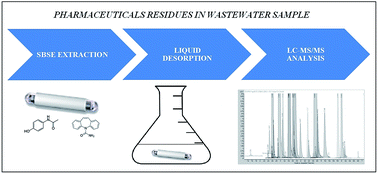当前位置:
X-MOL 学术
›
Anal. Methods
›
论文详情
Our official English website, www.x-mol.net, welcomes your feedback! (Note: you will need to create a separate account there.)
Multi-residue analysis of selected pharmaceuticals in wastewater samples by stir-bar sorptive extraction followed by liquid desorption and liquid chromatography-mass spectrometry
Analytical Methods ( IF 3.1 ) Pub Date : 2017-08-11 00:00:00 , DOI: 10.1039/c7ay01310h A. Klančar 1, 2, 3, 4, 5 , M. Zakotnik 1, 2, 3, 4, 5 , R. Roškar 1, 2, 3, 4, 5 , J. Trontelj 1, 2, 3, 4, 5
Analytical Methods ( IF 3.1 ) Pub Date : 2017-08-11 00:00:00 , DOI: 10.1039/c7ay01310h A. Klančar 1, 2, 3, 4, 5 , M. Zakotnik 1, 2, 3, 4, 5 , R. Roškar 1, 2, 3, 4, 5 , J. Trontelj 1, 2, 3, 4, 5
Affiliation

|
New organic pollutants such as pharmaceuticals have been recently classified as emerging pollutants. These are chemically active compounds and may pose a risk to environmental organisms as well as to humans. Nowadays, separation and analytical techniques enable detection and quantification at extremely low concentrations. We aimed to develop and optimise a new method that would minimise (organic) solvent consumption and miniaturise and simplify sample preparation through the use of stir-bar sorptive extraction of selected pharmaceuticals, followed by liquid desorption and liquid chromatography coupled to mass spectrometry. Several conditions and parameters that affect the extraction procedure (extraction time, sample pH, sample volume, extraction temperature, and addition of salt and organic modifier) were evaluated for suitable extraction efficiency. The optimised method (sample volume, 20 mL; sample pH, 9; extraction time, 150 min; and desorption time, 15 min; in an acetonitrile and methanol [50 :
: 50 v/v] mixture at 50 °C, without any added modifier) was validated and provided recoveries above 80% for 12 analytes, and for 6 analytes they were between 45% and 65%, while for another 6 analytes the recoveries were below 25%. The method provided a wide linear range (mainly 1.25–1250 ng L−1, R2 > 0.99) with very low limits of quantification for all analytes (1.25–5.0 ng L−1). The method was used to test 15 wastewater samples and 22 out of 24 monitored pharmaceuticals were detected, generally in concentrations below 200 ng L−1.
50 v/v] mixture at 50 °C, without any added modifier) was validated and provided recoveries above 80% for 12 analytes, and for 6 analytes they were between 45% and 65%, while for another 6 analytes the recoveries were below 25%. The method provided a wide linear range (mainly 1.25–1250 ng L−1, R2 > 0.99) with very low limits of quantification for all analytes (1.25–5.0 ng L−1). The method was used to test 15 wastewater samples and 22 out of 24 monitored pharmaceuticals were detected, generally in concentrations below 200 ng L−1.
中文翻译:

搅拌棒吸附萃取-液相解吸-液相色谱-质谱法对废水样品中的某些药物进行多残留分析
新的有机污染物,例如药品,最近被归类为新兴污染物。这些是具有化学活性的化合物,可能对环境生物以及人类构成威胁。如今,分离和分析技术可以在极低的浓度下进行检测和定量。我们的目标是开发和优化一种新方法,该方法将通过使用选定药物的搅拌棒吸附萃取,然后进行液相脱附和液相色谱与质谱联用,来最大限度地减少(有机)溶剂的消耗,并最小化和简化样品的制备。影响萃取程序的几种条件和参数(萃取时间,样品pH,样品量,萃取温度,以及添加盐和有机改性剂的效果)进行了评估。优化的方法(在乙腈和甲醇中[50,样品量为20 mL;样品pH为9;萃取时间为150分钟;解吸时间为15分钟] :
: 验证了在50°C下没有添加任何改性剂的50 v / v]混合物),并提供了12种分析物的回收率在80%以上,而6种分析物的回收率在45%至65%之间,而另外6种分析物的回收率是低于25%。该方法提供了宽的线性范围(主要为1.25–1250 ng L -1,R 2 > 0.99),并且所有分析物的定量限都非常低(1.25–5.0 ng L -1)。该方法用于测试15个废水样品,检测到24种受监测药物中的22种,其浓度通常低于200 ng L -1。
验证了在50°C下没有添加任何改性剂的50 v / v]混合物),并提供了12种分析物的回收率在80%以上,而6种分析物的回收率在45%至65%之间,而另外6种分析物的回收率是低于25%。该方法提供了宽的线性范围(主要为1.25–1250 ng L -1,R 2 > 0.99),并且所有分析物的定量限都非常低(1.25–5.0 ng L -1)。该方法用于测试15个废水样品,检测到24种受监测药物中的22种,其浓度通常低于200 ng L -1。
更新日期:2017-09-21
 :
: 50 v/v] mixture at 50 °C, without any added modifier) was validated and provided recoveries above 80% for 12 analytes, and for 6 analytes they were between 45% and 65%, while for another 6 analytes the recoveries were below 25%. The method provided a wide linear range (mainly 1.25–1250 ng L−1, R2 > 0.99) with very low limits of quantification for all analytes (1.25–5.0 ng L−1). The method was used to test 15 wastewater samples and 22 out of 24 monitored pharmaceuticals were detected, generally in concentrations below 200 ng L−1.
50 v/v] mixture at 50 °C, without any added modifier) was validated and provided recoveries above 80% for 12 analytes, and for 6 analytes they were between 45% and 65%, while for another 6 analytes the recoveries were below 25%. The method provided a wide linear range (mainly 1.25–1250 ng L−1, R2 > 0.99) with very low limits of quantification for all analytes (1.25–5.0 ng L−1). The method was used to test 15 wastewater samples and 22 out of 24 monitored pharmaceuticals were detected, generally in concentrations below 200 ng L−1.
中文翻译:

搅拌棒吸附萃取-液相解吸-液相色谱-质谱法对废水样品中的某些药物进行多残留分析
新的有机污染物,例如药品,最近被归类为新兴污染物。这些是具有化学活性的化合物,可能对环境生物以及人类构成威胁。如今,分离和分析技术可以在极低的浓度下进行检测和定量。我们的目标是开发和优化一种新方法,该方法将通过使用选定药物的搅拌棒吸附萃取,然后进行液相脱附和液相色谱与质谱联用,来最大限度地减少(有机)溶剂的消耗,并最小化和简化样品的制备。影响萃取程序的几种条件和参数(萃取时间,样品pH,样品量,萃取温度,以及添加盐和有机改性剂的效果)进行了评估。优化的方法(在乙腈和甲醇中[50,样品量为20 mL;样品pH为9;萃取时间为150分钟;解吸时间为15分钟]
 :
: 验证了在50°C下没有添加任何改性剂的50 v / v]混合物),并提供了12种分析物的回收率在80%以上,而6种分析物的回收率在45%至65%之间,而另外6种分析物的回收率是低于25%。该方法提供了宽的线性范围(主要为1.25–1250 ng L -1,R 2 > 0.99),并且所有分析物的定量限都非常低(1.25–5.0 ng L -1)。该方法用于测试15个废水样品,检测到24种受监测药物中的22种,其浓度通常低于200 ng L -1。
验证了在50°C下没有添加任何改性剂的50 v / v]混合物),并提供了12种分析物的回收率在80%以上,而6种分析物的回收率在45%至65%之间,而另外6种分析物的回收率是低于25%。该方法提供了宽的线性范围(主要为1.25–1250 ng L -1,R 2 > 0.99),并且所有分析物的定量限都非常低(1.25–5.0 ng L -1)。该方法用于测试15个废水样品,检测到24种受监测药物中的22种,其浓度通常低于200 ng L -1。


























 京公网安备 11010802027423号
京公网安备 11010802027423号